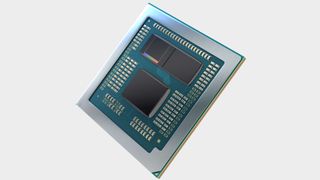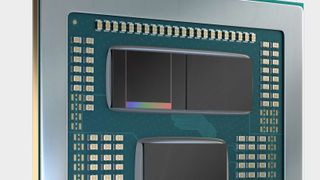AMD Ryzen 9 7945HX3D hands-on testing: So, I guess AMD just makes all the best mobile chips now
The red team has brought its X3D CPU technology to the gaming laptop and honestly it slaps.

Well, now I don't want an Intel gaming laptop anymore. For so long the received wisdom has been the ideal combination for a mighty mobile PC is an Intel processor and an Nvidia graphics card. Indeed, that's how it's been on the desktop for a long time, too.
But no longer. AMD has come back into the game in a big way in our big ol' gaming machines, and now it's swinging wildly on the gaming laptop side, too. I mean, you still largely want an Nvidia GPU, but the choice of number crunching chip is tinged more red than blue right now.
The absolute fastest gaming CPU around right now is the Ryzen 7 7800X3D, offering the tippiest of tip top gaming frame rates whatever graphics card you slap in alongside it. And now AMD has taken the same 3D V-Cache trickery which has made that such a potent gaming chip and dropped it on top of its finest mobile CPU.
The AMD Ryzen 9 7945HX3D is that new chip, sporting a total of 144MB of L2+L3 cache, 16 cores of Zen 4 processing power, with 32 threads, and a boost clock of 5.4GHz. It's basically identical to the Ryzen 9 7945HX CPU, which we've already seen in the excellent Asus ROG Strix Scar 17, and that was already an outstanding mobile CPU.

Cache is king: What will a CPU look like in the future?
Essentially it was already the best mobile chip for gaming, but the extra 64MB of 3D V-Cache has added an extra literal layer of frosting on top of that chip. Or, more explicitly, on top of one of the compute chiplets in that processor.
It's long been the way, if all else fails: throw some more cache at it. It's happening across the board—Intel's doing it in CPUs, too, and Ada showed Nvidia is joining AMD in ramping up the cache levels on their graphics cards.
The 3D V-Cache tech is, more or less, a pretty brute force method of squeezing another level of gaming performance out of your system. There are no fancy algorithms, no elegant changes to the pipeline, just fancy packaging that lumps double the L3 cache on top of one of the twin eight-core chiplets in the package.
The biggest gaming news, reviews and hardware deals
Keep up to date with the most important stories and the best deals, as picked by the PC Gamer team.
That's maybe a grotesque over-simplification of the work AMD's engineers have put in to ensure that a vertically package chunk of memory can be seen as essentially a single pool of fast memory, but the ethos is straightforward: Get more memory stuffed directly into the chip.
Games hugely benefit from low latency access to the vast amount of data needed to render our game worlds. And the closer you can get the memory to your actual processing cores, the faster everything runs. By increasing the amount of L3 cache available to this new Ryzen mobile chip it now has a relatively huge 128MB of memory with which to store game data.

And when you consider that not everything is a huge texture file—there are myriad small data points needed to be pushed around to make our games feel alive—then doubling that L3 cache means the CPU doesn't have to go looking further than that for the data it needs. Once you start missing L3 hits you get into the relatively slow lane of system memory, that's when you get slow downs.
It's definitely effective, too. I've had the retooled Asus ROG Strix Scar 17 with the new X3D chip inside it for a few days now, and have had a chance to see how it games. It's great that we've already tested the exact same laptop, with almost the exact same chip, in the last month or so, because it gives us the chance to see exactly what benefit the 3D V-Cache has had on gaming performance.
1080p gaming performance





AMD claims that it is, on average more than 15% faster than the standard Ryzen 9 7945HX. In our testing… well, not so much. In fact, in the five games we've had a chance to test the two machines directly against each other, the best performance increase we've seen has been 12%. That's looking at 1080p frame rates on the top settings. More regularly our results are below 10% in the 5 - 9% region.
1440p performance





Synthetic performance





But our test suite is deliberately punishing in a lot of instances and designed to push even this sort of top tech spec to the limits. And that means we're largely GPU bound, especially in something like Cyberpunk 2077, with UItra ray tracing settings. At that level the GPU is working as hard as it can and no amount of extra cache is going to deliver a truly sizable performance increase.
With lower settings, and maybe with more casual, or esports/competitive-focused games, the delta is likely to be a lot bigger, and more in line with AMD's own 15%+ expectations. But that's not what I'm going to want to do with my top-end Nvidia GPU with a monstrously powerful CPU tacked on to it. I want to play the most demanding titles on the highest settings, and win.
Still, considering the Asus machine with the 7945HX and RTX 4090 combo was already delivering the highest gaming laptop frame rates we've ever seen, getting any improvement on that is ace.

It's not quite the be-all, do-all chip, though it is certainly the fastest mobile gaming CPU.
So, AMD has once again demonstrated that its X3D CPU enhancement can really deliver the goods in gaming. But there are still certain issues with its deployment. Like the desktop AMD Ryzen 9 7950X3D, you're relying on Windows to punt applications to what it sees as the most relevant core complex for the task. Should it go to the eight-core chiplet that has the extra cache, but likely slower clock speed, or the cache-lite eight-core chiplet that can go at full throttle?
This split decision on the actual hardware—one slower chiplet with more cache and one faster chiplet without—actually means in heavily multithreaded applications the Ryzen 9 7945HX3D is actually less performant than the non-3D V-Cache Ryzen 9 7945HX CPU. So, it's not quite the be-all, do-all chip, though it is certainly the fastest mobile gaming CPU.
CPU performance




It's also a big shame that AMD is so far restricting the technology to one processor. And worse still, in one laptop. I mean, I like the ROG Strix Scar 17, but it's not the one I'd buy with my own money. But here it, the one and for the time being only 3D V-Cache machine.
"This will be available in one laptop," AMD's Donny Woligroski tells us in an earlier briefing. "So, this will be exclusively available, for the foreseeable future, in the Asus ROG Strix Scar 17."
Restricting it to a single CPU in a single laptop model seem ludicrous to me.
At least give us an eight-core Ryzen 7 7745HX3D that we can have inside the wee Asus ROG Zephyrus G14 or, even better, the Razer Blade 14. Then I'll be all over it, and it'll make sense as a more streamlined, resolutely gaming chip in the perfect gaming laptop form factor. The 17-inch scale isn't where it's at for the best notebooks, and that shows in their low popularity.
Right now, as good as the hardware is—as we already knew it was given the performance of the desktop X3D chips—restricting it to a single CPU in a single laptop model seem ludicrous to me.
The Ryzen 9 7945HX3D is great, and right now can easily claim to be the most powerful gaming laptop processor there has ever been. And a full X3D lineup could deliver a suite of gaming notebooks Intel couldn't compete with. As it is, however, the mighty tech is destined to be limited to some sort of almost mythical halo product strangled by a hugely restrictive rollout in the least popular form factor of any laptop.

Dave has been gaming since the days of Zaxxon and Lady Bug on the Colecovision, and code books for the Commodore Vic 20 (Death Race 2000!). He built his first gaming PC at the tender age of 16, and finally finished bug-fixing the Cyrix-based system around a year later. When he dropped it out of the window. He first started writing for Official PlayStation Magazine and Xbox World many decades ago, then moved onto PC Format full-time, then PC Gamer, TechRadar, and T3 among others. Now he's back, writing about the nightmarish graphics card market, CPUs with more cores than sense, gaming laptops hotter than the sun, and SSDs more capacious than a Cybertruck.
Most Popular




